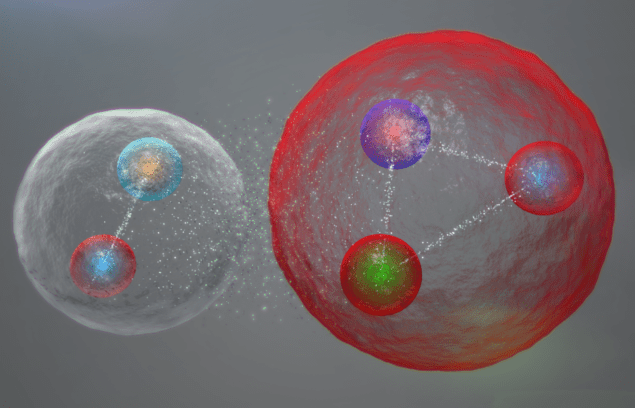LHCb bags another pentaquark
27 Mar 2019 Hamish Johnston
A new pentaquark – an exotic hadron comprising five quarks – has been discovered by physicists working on the LHCb experiment at CERN. LHCb scientists have also found that a feature in their data that had previously been associated with one pentaquark could be evidence for two pentaquarks with similar masses.
Hadrons are heavy particles that are made of two or more quarks held together by the strong force. Until the early 2000s, physicists had concrete evidence for only two types of hadron: baryons (such as protons and neutrons) containing three quarks and mesons, which contain a quark and antiquark. Preliminary analysis of the three pentaquarks suggests that they have a molecular structure that resembles a meson bound to a baryon (see figure). Gaining a better understanding of how pentaquarks are bound together could provide important insights into the strong force and quantum chromodynamics.
Not surprising
Since then, physicists have discovered tetraquarks containing four quarks and pentaquarks containing five. This has not come as a complete surprise because when Murray Gell-Mann first proposed the quark model in 1964, he realized that quark-antiquark pairs could be added to mesons and baryons to create heavier particles.
The first tetraquark was discovered formally (with a statistical significance greater than 5σ) at Japan’s BELLE experiment in 2008. The first two pentaquarks – called Pc(4450)+ and Pc(4380)+ – were discovered in 2015 at LHCb using proton-proton collision data from Run 1 of the Large Hadron Collider (LHC). The four-digit number refers to the mass of the pentaquark in MeV/c2, which means that these pentaquarks are more than four times heavier than the proton.
Using new data from Run 2 of the LHC, physicists have discovered a third pentaquark called Pc(4312)+, which they have observed at a statistical significance of 7.3σ. What is more, they also have 5.4σ evidence that the mass peak in the Run 1 data associated with Pc(4450)+ is actually two peaks. They believe these correspond to two different pentaquarks, which they have dubbed Pc(4440)+ and Pc(4457)+.
LHCb team member Tim Gershon of the University of Warwick told Physics World that combining data from Run 1 and Run 2 means that the pentaquark peaks are now much better resolved than in previous studies. Gershon and colleagues found that the three peaks are narrow, which means that the pentaquark particles enjoy relatively long lifetimes before they decay.
Long lifetimes suggest that these pentaquarks resemble molecules that comprise a baryon and a meson bound together by the residual strong force – which is the force that binds neutrons and protons together in a nucleus. The mass of the Pc(4312)+, for example, is just below combined masses of a Ʃc+ baryon and a neutral D meson. Such a configuration is expected to be relatively stable and therefore correspond to a narrow peak.
Gershon says that the LHCb team is currently doing a much more sophisticated analysis on the collision, which should reveal the spin and parity of the pentaquarks. This would provide crucial information about the internal structures of the pentaquarks.
The recent discoveries were described in a talk by Syracuse University’s Tomasz Skwarnicki at the Rencontres de Moriond conference in Italy.
Tim Gershon and Greig Cowan explore the physics of exotic hadrons in Tetraquarks and Pentaquarks, which is part of the Physics World Discovery series of ebooks.
PHYSICSWORLD.COM 30/3/2019

Δεν υπάρχουν σχόλια:
Δημοσίευση σχολίου